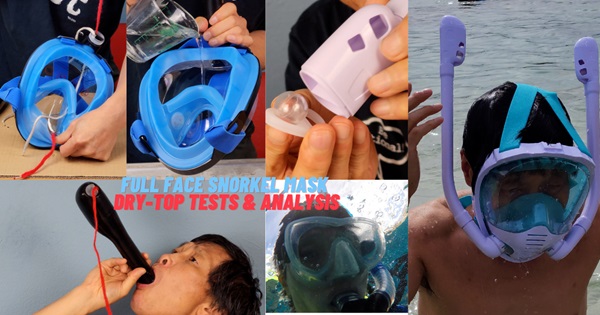https://youtu.be/GuEwcsXAdJ8 The Full Face Snorkel Mask (FFSM) market has witnessed significant growth in recent years because of the obvious advantages: Natural breathing, masks can seal better than goggles, better visibility, and anti-fog. It is so easy for beginners, if you don’t intend to dive deep. However you may hear some people advise against using it. This video is going to have a detailed analysis and show you how to test your mask to check for problems.
This video used two different Full Face Masks as typical examples. You may see different models with new improvements in the future. However you can also follow our analysis discussed in this video: identify the mask’s two parts, the eye-pocket and the oronasal pocket. Then trace the inhale and exhale paths separately. Pay attention to the location of any unidirectional valves. This will help you to devise a plan for testing similar to the 3-Step Full Face Snorkel Mask Test & 3-Step Dry Top Test presented in this video.
We hope this video can bring attention to the safety issues. The issues discussed in this video can be found in two papers at NIH (National Institutes of Health). This is one 2023 paper at https://www.ncbi.nlm.nih.gov/pmc/articles/PMC10735670/ , the conclusion: “Use of FFSMs may result in rebreathing due to non-unidirectional flow, leading to hypercapnia.” Another 2022 paper at https://pubmed.ncbi.nlm.nih.gov/35226974/ read: “mask models showed patterns of increasing breathing resistance with water intrusion … and this increased resistance could potentially create elevated levels of respiratory distress”
Timestamp
0:0 Full Face Snorkel Mask Advantages
0:22 goal to compare 3 masks & detailed analysis
0:40 safety concern papers from National Institutes of Health
1:11 double tubes & single tube full face masks
1:27 eye-pocket & oronasal pocket
1:39 inhale air path
1:53 one way valves
2:04 exhale one way valve
2:15 two exhale paths
2:38 divided tube, half inhale & half exhale
3:06 normal vs malfunction unidirectional valves
3:41 3-step unidirectional valve tests
3:53 step 2: test face & mask seal
4:03 step 3: unidirectional valve test
4:37 another Full Face Mask analysis
4:48 no unidirectional valve for inhale path
5:12 three exhale paths
6:16 dry top
6:49 trace inhale path with white shoelaces
7:13 teardown dry top tube
7:31 trace exhale path with red shoelaces
7:44 3-step dry top test
8:10 step 2: open inhale path
8:27 step 3: exhale path blow
8:42 water drain test
8:56 Full Face Mask disadvantages
9:14 equalizing ear pressure
9:55 not dive deep

